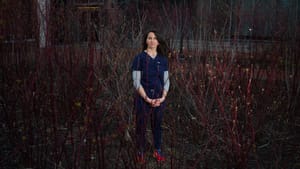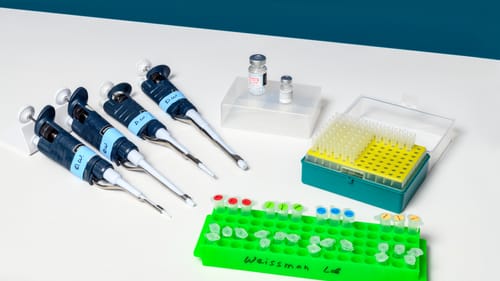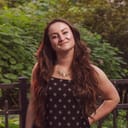Stay in the Loop
BSR publishes on a weekly schedule, with an email newsletter every Wednesday and Thursday morning. There’s no paywall, and subscribing is always free.
Five years later: remembering pandemic heroes
The Mütter Museum presents Trusted Messengers: Community, Confidence, and COVID-19

Five years after the advent of the Covid pandemic, the Mütter Museum shines a light on the healthcare workers, researchers, and reporters who brought us the eyewitness truth with a new special exhibition. Trusted Messengers: Community, Confidence, and COVID-19 is dedicated to the flood of fear, breakthroughs, and fatigue as our world reeled from an invisible enemy.
The show honors our healthcare workers with incredible stories, striking photos, and a clear set of floor sticker instructions. Good news for my fellow rule-lovers: simply follow the arrows and find yourself at the center of a moment in history.
Hope and horror
The sheer volume of messages and snapshots is a lot to digest. Photos of beautifully stitched patterns flow across cloth masks and bright posters remind us to stay six feet away from others. The uplifting aura sparks feelings of hope: we could create and maintain a world that protects the vulnerable. But that feeling is slapped out of my skull from the words on another poster: “how do you shelter in place when you don’t have a home?”
I found myself walking around the exhibition wondering: how do we possibly mark five years since the world stopped? How did the healthcare landscape react when its systems were stress tested? Covid deepened the systemic gaps that people fell through. The question “How do you wash your hands when you don’t have a sink?” glares from another wall.
I followed the arrow stickers and focused on an evolving series of figures. Fascinated and slowly horrified by the numbers through years of surges and superspreaders, the data from the period immediately following 2020 paints a stark image.
Rough times
Take a step to the next sticker and learn that “Data from the Census Bureau shows that deaths in the US increased 19% after the onset of the pandemic, the largest spike in 100 years.” Next, a floor marker for May 12, 2022: the day the number of recorded deaths from Covid surpassed 1,000,000 people in the United States.
We all have different snippets of that shared memory. Gritty visiting nurses at overwhelmed hospitals. Unhinged TikTok trends. Numb horror from the loss of human life. Zoom dating. Things were rough.
I still think about the tone-deaf government guidance toward panicked Americans: “It’s never too late to start setting up an emergency fund. First, you’ll need to know the total funds you need. Then you can figure out how much you should aim to save each month.” Meanwhile, medical debt is a leading cause of bankruptcy for US citizens. Studies suggest that 500,000 people are pushed into bankruptcy each year from the current price gouging of medical expenses. Another floor sticker marking March 2022 reads, “CDC data shows that 44% of high schoolers report feeling persistently sad or hopeless. LGBTQ+ youth report the poorest overall mental health.”
The path to a life-saving shot
In a crisis, it’s hard to know the right move right away. Hearing someone yell “fire” doesn’t mean “gather a committee to debate the merits of firetrucks.” We should already be on the phone with the fire department. Photos and illustrations of approved healthcare guidance plaster the walls featuring hands reaching out to each other. I consider the “Trusted Messengers” title in the context of the frantic research conducted during those first few months of lockdown.

In one corner of the room, lab equipment shines under a bright light. Pipettes, test tubes, and miniscule racks populate a tabletop diorama. A giant banner photo of two doctors looms from the ceiling above the display case. The giant scale of Dr. Katalin Kariko and Dr. Drew Weissman’s portraits matches the size of their breakthrough. They were jointly awarded the 2023 Nobel Prize in Physiology or Medicine when their research on vaccine technology became the basis for the first two Covid vaccines approved by the FDA. The simple tools on display produced a shot that saved millions of lives.
Wartime energy
Across the room, photographer Kyle Cassidy created a stunning portrait series featuring pandemic nurses. The portraits are printed onto ripped, used mask fabric. The result is uniquely haunting. The photos carry a Civil War-era energy, portraits of mid-battle soldiers. Written accounts of their experiences are featured in the display.
“There have been patients who recovered,” one reads. “One man sends us a bouquet of flowers once a month with a thank you note. We’ve gotten five of them so I know at least he recovered. He’s sent pictures of himself and says that he’s doing well.”
I stare into photos of hard, exhausted eyes of nurses and doctors. The workers who cared for the sick and held the hands of the dying experienced immeasurable trauma. Many healthcare workers left the industry for good once their career turned into a waking nightmare.
Dr. Weissman, who is quoted here, achieved his goal. “My dream was always that we develop something in the lab that helps people. I’ve satisfied my life’s dream.”
What, When, Where
Trusted Messengers: Community, Confidence, and COVID-19. Through February 2, 2026 at the Mütter Museum of the College of Physicians of Philadelphia, 19 S. 22nd Street, Philadelphia, PA. (215) 563-3737 or MutterMuseum.org.
Accessibility
The Mütter Museum is accessible to people using standard-size wheelchairs.
Sign up for our newsletter
All of the week's new articles, all in one place. Sign up for the free weekly BSR newsletters, and don't miss a conversation.

 Erin Dohony
Erin Dohony